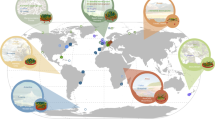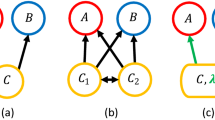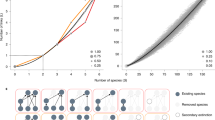Abstract
Several of the most ambitious theories in ecology1,2,3,4,5,6,7,8,9,10,11,12,13,14 describe food webs that document the structure of strong and weak trophic links9 that is responsible for ecological dynamics among diverse assemblages of species4,11,12,13. Early mechanism-based theory asserted that food webs have little omnivory and several properties that are independent of species richness1,2,3,4,6. This theory was overturned by empirical studies that found food webs to be much more complex5,7,8,9,14,15,16,17,18, but these studies did not provide mechanistic explanations for the complexity9. Here we show that a remarkably simple model fills this scientific void by successfully predicting key structural properties of the most complex and comprehensive food webs in the primary literature. These properties include the fractions of species at top, intermediate and basal trophic levels, the means and variabilities of generality, vulnerability and food-chain length, and the degrees of cannibalism, omnivory, looping and trophic similarity. Using only two empirical parameters, species number and connectance, our ‘niche model’ extends the existing ‘cascade model’3,19 and improves its fit ten-fold by constraining species to consume a contiguous sequence of prey in a one-dimensional trophic niche20.
This is a preview of subscription content, access via your institution
Access options
Subscribe to this journal
Receive 51 print issues and online access
$199.00 per year
only $3.90 per issue
Buy this article
- Purchase on Springer Link
- Instant access to full article PDF
Prices may be subject to local taxes which are calculated during checkout




Similar content being viewed by others
References
May, R. M. How many species are there on earth? Science 241, 1441–1449 (1988).
Lawton, J. H. in Ecological Concepts (ed. Cherrett, J. M.) 43– 78 (Blackwell Scientific, Oxford, 1989).
Cohen, J. E., Briand, F. & Newman, C. M. Community Food Webs: Data and Theory (Biomathematics Vol. 20) (Springer, Berlin, 1990).
Pimm, S. L., Lawton, J. H. & Cohen, J. E. Food web patterns and their consequences. Nature 350, 669–674 ( 1991).
Polis, G. A. Complex desert food webs: an empirical critique of food web theory. Am. Nat. 138, 123–155 ( 1991).
Havens, K. Scale and structure in natural food webs. Science 257 , 1107–1109 (1992).
Martinez, N. D. Effects of scale on food web structure. Science 260 , 242–243 (1993).
Martinez, N. D. Scale-dependent constraints on food-web structure. Am. Nat. 144, 935–953 (1994).
Lawton, J. H. Webbing and WIWACS. Oikos 72, 305– 306 (1995).
Polis, G. A. & Winemiller, K. (Eds) Food Webs: Integration of Patterns and Dynamics (Chapman and Hall, New York, 1996).
deRuiter, P. C., Neutel, A-M & Moore, J. C. Energetics, patterns of interaction strengths, and stability in real ecosystems. Science 269, 1257–1260 (1995).
McCann, K., Hastings, A. & Huxel, G. R. Weak trophic interactions and the balance of nature. Nature 395, 794–798 (1998).
Berlow, E. L. Strong effects of weak interactions in ecological communities. Nature 398, 330–334 ( 1999)
Schoener, T. W. Food webs from the small to the large. Ecology 70, 1559–1589 (1989).
Warren, P. H. Spatial and temporal variation in the structure of a freshwater food web. Oikos 55, 299–311 (1989).
Hall, S. J. & Raffaelli, D. Food-web patterns: lessons from a species-rich web. J. Anim. Ecol. 60, 823 –842 (1991).
Martinez, N. D. Artifacts or attributes? Effects of resolution on the Little Rock Lake food web. Ecol. Monog. 61, 367– 392 (1991).
Goldwasser, L. & Roughgarden, J. Construction of a large Caribbean food web. Ecology 74, 1216–1233 (1993).
Solow, A. R. & Beet, A. R. On lumping species in food webs. Ecology 79, 2013–2018 (1998).
Cohen, J. E. Food Webs and Niche Space (Princeton Univ. Press, Princeton, 1978).
Murtaugh, P. A. & Kollath, J. P. Variation of trophic fractions and connectance in food webs. Ecology 78, 1382–1287 (1997).
Huxman, M., Raffaelli, D. & Pike, A. Parasites and food web patterns. J. Anim. Ecol. 64, 168–176 ( 1995).
Marcogliese, D. J. & Cone, D. K. Food webs: A plea for parasites. Trends Ecol. Evol. 12, 320 –325 (1997).
Hutchinson, G. E. Concluding remarks. Population studies: Animal ecology and demography. Cold Spring Harbor Symp. Quant. Biol. 22, 415– 427 (1957).
Warren, P. H. in Aspects of the Genesis and Maintenance of Biological Diversity (eds Hochberg, M. E., Clobert, J. & Barbault, R.) 142– 161 (Oxford Univ. Press, New York, 1996).
Begon, M., Harper, J. L. & Townsend, C. R. Ecology: Individuals, Populations, and Communities 3rd edn (Blackwell Science, Oxford, 1996).
Warren, P. H. & Lawton, J. H. Invertebrate predator–prey body size relationships: an explanation for upper triangular food webs and patterns in food web structure? Oecologia 74, 231–235 (1987).
Cohen, J. E., Pimm, S. L., Yodzis, P. & Saldana, J. Body sizes of animal predators and animal prey in food webs. J. Anim. Ecol. 62, 67–78 (1993).
Symstad, A. J., Tilman, D., Willson, J. & Knops, J. M. H. Species loss and ecosystem functioning: effects of species identity and community composition. Oikos 81, 389–397 (1998).
Baird D. & Ulanowicz, R. E. The seasonal dynamics of the Chesapeake Bay ecosystem. Ecol. Monogr. 59, 329–364 (1989).
Acknowledgements
We thank J. Dunne, M. Geluardi, E. Connor, L. Goldwasser, J. Harte, T. Parker, E. Berlow and I. Billick for comments and suggestions. The USA National Science Foundation provided support.
Author information
Authors and Affiliations
Corresponding author
Supplementary information
Rights and permissions
About this article
Cite this article
Williams, R., Martinez, N. Simple rules yield complex food webs. Nature 404, 180–183 (2000). https://doi.org/10.1038/35004572
Received:
Accepted:
Issue Date:
DOI: https://doi.org/10.1038/35004572
This article is cited by
-
Ecological determinants of Cope’s rule and its inverse
Communications Biology (2024)
-
Adaptive rewiring shapes structure and stability in a three-guild herbivore-plant-pollinator network
Communications Biology (2024)
-
Impacts of Aggregation Methods and Trophospecies Number on the Structure and Function of Marine Food Webs
Journal of Ocean University of China (2024)
-
Parasites alter food-web topology of a subarctic lake food web and its pelagic and benthic compartments
Oecologia (2024)
-
Reactivity of complex communities can be more important than stability
Nature Communications (2023)
Comments
By submitting a comment you agree to abide by our Terms and Community Guidelines. If you find something abusive or that does not comply with our terms or guidelines please flag it as inappropriate.



